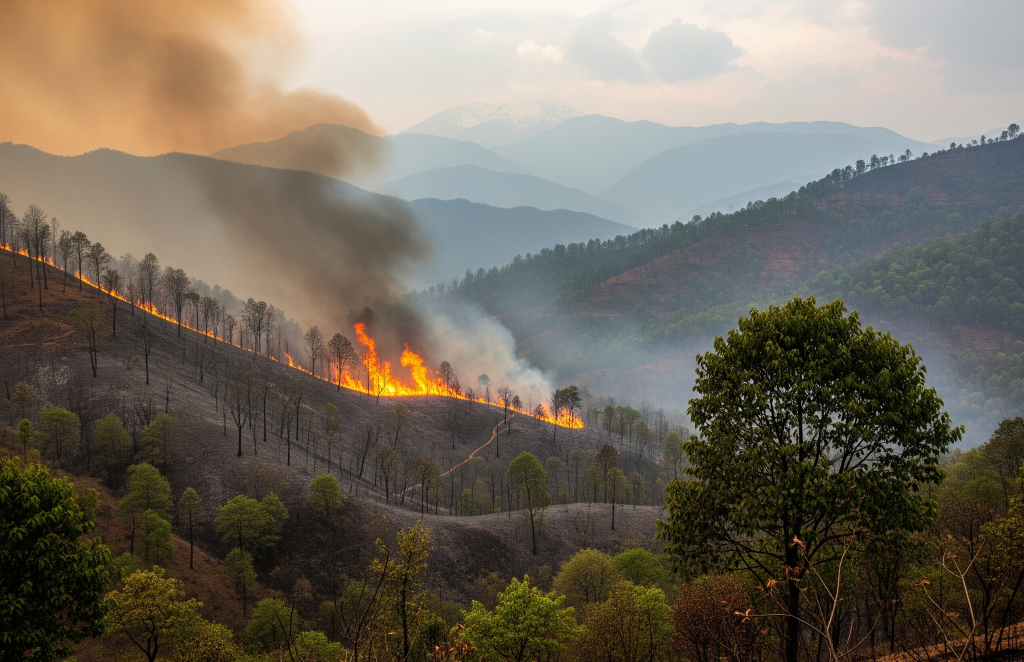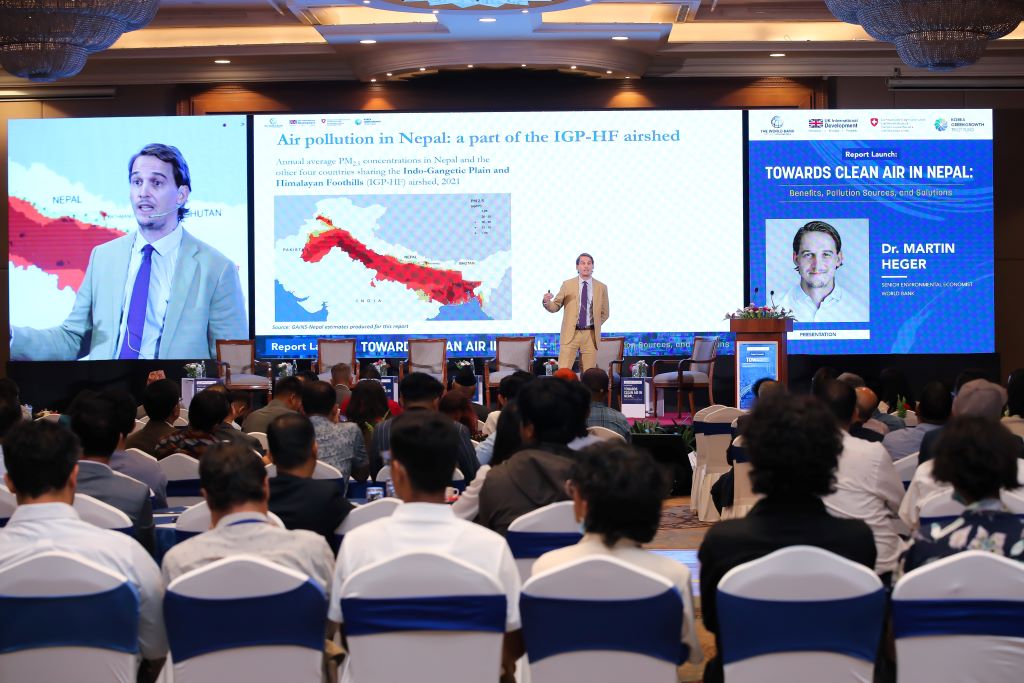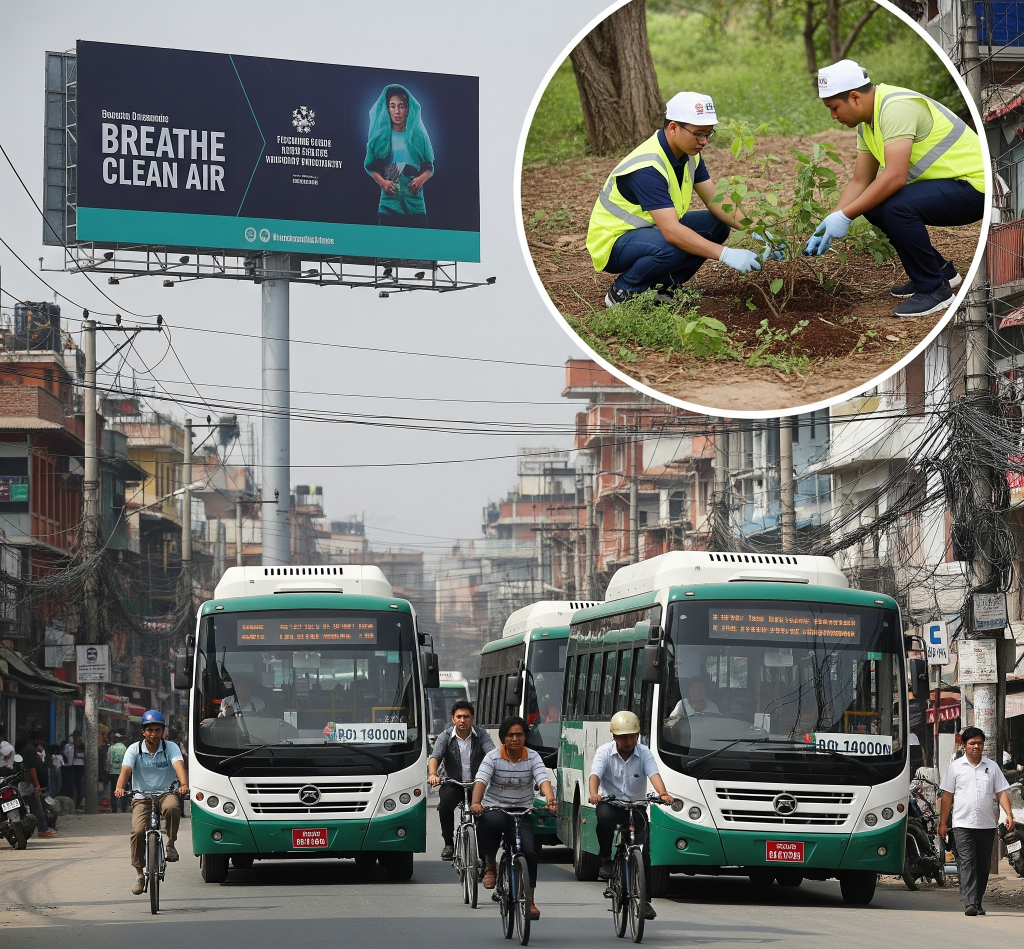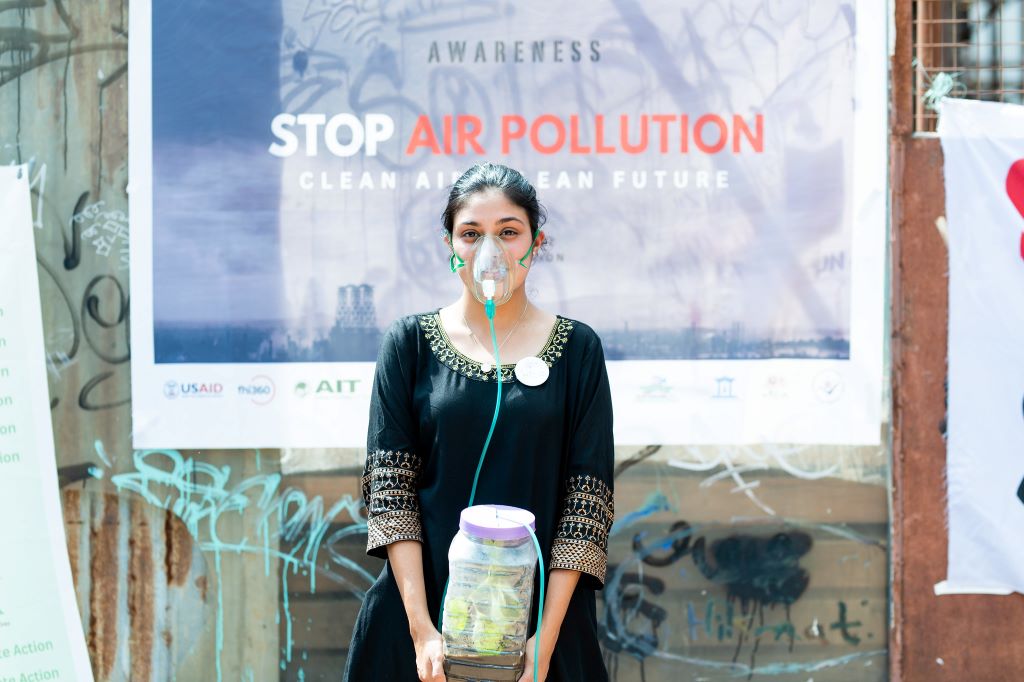Nepal's air pollution has escalated into a national emergency, with toxic air severely impacting health, economy, and daily life. Change needs bold policies, public action, and sustainable investment.

July 04, 2025
Kathmandu, Nepal

Air pollution by brick factories at Mahalaxmi municipality, Lalitpur Nepal.
Photo: Wikimedia Commons/ Janak Bhatta
At 8 a.m. in Kathmandu, the roads are already packed with honking vehicles and clouds of dust. People cover their faces with scarves or masks not for fashion, but to protect themselves from the polluted air they breathe every day. What used to be a city with fresh mountain air and clear views is now covered in thick, dirty smog that doesn’t seem to be going away.
Toxic air is causing billions in health-related losses, including rising healthcare costs, premature deaths, lower worker productivity, missed school days, and a decline in Nepal’s tourism appeal. Across the Kathmandu valley and terrains of Nepal, the air has grown dense not just with dust and smoke, but with the unseen burden of policy failures, rapid urbanization, and public inaction.
A recent report, titled "Towards Clean Air in Nepal: Benefits, Pollution Sources, and Solutions", published by the World Bank (WB) Group, revealed that poor air quality is estimated to cost Nepal more than 6% of its Gross Domestic Product (GDP) annually. While growth projects boom and roads are built, millions of Nepalis are literally choking on progress.
Air pollution in Nepal has evolved from a seasonal concern into a year-round public health emergency. In the first quarter of 2025, the Kathmandu Valley experienced 75 out of 90 days with air quality rated as “unhealthy,” according to an analysis by ICIMOD.
The crisis reached a peak on April 8, 2025, when Kathmandu was briefly ranked the most polluted city in the world, according to Swiss air quality monitoring firm IQAir, with an Air Quality Index (AQI) soaring to 279, placing it in the “very unhealthy” category. On that day, PM 2.5 concentrations were measured at 204.5 µg/m³, with PM 10 levels reaching 233.5 µg/m³, making the PM 2.5 pollution nearly 41 times higher than the World Health Organization’s annual recommended limit.

Forest fire burns through hillside in Nepal, highlighting rising wildfire risks.
Photo: Gemini Google AI
Nepal’s worsening air quality stems from a toxic blend of natural and human-induced factors. The major contributors include:
Vehicular Emissions: A large number of old and poorly maintained vehicles emit significant amounts of nitrogen oxides, carbon monoxide, and particulate matter. Nepal's vehicle count has soared from 801 in 1977 to 5.53 million in 2024, with 203,552 new registrations this year alone. The number of vehicles in the Bagmati zone, most of which are in Kathmandu Valley, is growing by more than 12% each year, with many aging diesel vehicles emitting harmful pollutants that combined with traffic congestion and thermal inversion contributed significantly, contribute 30% to pollution, a problem that remains critical in 2025.
Open Burning and Forest Fires: Agricultural burning, household waste incineration, and wildfires intensify pollution, especially in spring and winter. Forest fire activity, as per ICIMOD’s report, has more than doubled in Nepal over the past decade, with 2025 projected to be the worst year yet, contributing around 40% of recent air pollution in Kathmandu Valley and becoming a major pollution source during Nepal’s dry season. These fires release large amounts of harmful pollutants, significantly worsening air quality and health risks.
Industrial activities: Factories, brick kilns, and other industrial activities release large amounts of pollutants into the air. According to the report Causes and Consequences of Air Pollution in Nepal, there are over 1,700 brick kilns in operation in Nepal, with over 110 located in Kathmandu Valley, producing over five billion bricks per year. Industry-related emissions account for slightly more than a quarter of Nepal’s energy-related CO₂ emissions and increased by 24% between 2012 and 2017.
Domestic Pollution: It is caused by cooking with LPG, kerosene, wood dust, and cow dung, particularly among low-income households in congested areas, resulting in harmful indoor air pollution that severely impacts health.
Transboundary pollution: Pollution from neighboring countries, especially India and China, significantly affects air quality in Nepal, contributing about a quarter of the pollution in Kathmandu Valley and even more in the Terai region.
Construction Activities and Dust Pollution: Unregulated construction and road expansion projects release large amounts of fine dust, especially during dry seasons with minimal rainfall. A report on Air Quality Status and Management in Kathmandu Valley estimates that such dust accounts for about 25% of the city’s air pollution.

Dr. Martin Heger from the World Bank presents key findings on Nepal’s air pollution from the World Bank’s air pollution report at its launch in Kathmandu on June 17, 2025.
Photo: Devpulse
In a recent event held, Martin Heger, Senior Environmental Economist at the World Bank, painted a disturbing picture. “Air pollution is now Nepal’s leading cause of death and disability, surpassing malnutrition and tobacco use. It causes an estimated 26,000 premature deaths annually and reduces the average Nepali’s life expectancy by 3.4 years.”
According to the Climate Transparency Report 2020, outdoor air pollution causes nearly 22,000 deaths annually in Nepal from stroke, heart disease, lung cancer, and chronic respiratory illnesses. Outdoor workers such as daily wage laborers, street vendors, and traffic police face chronic exposure, raising risks for respiratory diseases, eye irritation, and other health problems.
As per Heger, “Air pollution costs Nepal over 6% of its GDP annually by reducing labor productivity and damaging the tourism and aviation sectors. Poor air quality diminishes Nepal’s scenic allure, discouraging tourists and reducing local business revenues.”
Frequent smog and haze disrupt aviation with flight delays and cancellations, raising operational costs and straining the economy further. Without urgent intervention, the report concludes, these impacts are projected to worsen significantly by 2035.
Nepal is addressing air pollution through legal, technological, fiscal, and strategic measures, though critics say stronger government action is needed. The Nepal Constitution (Article 30) guarantees the right to a clean environment, supported by the Environment Protection Act (2019), Regulation (2020), and National Environment Policy (2019), all focusing on pollution control and sustainable development. To ensure accountability, Nepal adopted the National Ambient Air Quality Standards (NAAQS) in 2012, covering nine major pollutants.
As Prakash K.C., Environment inspector at the Department of Environment, noted in an interview, “Monitoring efforts, largely supported by partners like USAID and ICIMOD, have been established across all seven provinces to track pollutants like Particulate matter (PM), Carbon monoxide (CO), Sulphur dioxide (SO₂), Nitrogen Oxides (NO₂), and Ozone (O₃). While 30 stations have now been set up by the Department of Environment, only 16 are currently contributing data due to technical failures, data validity problems, and data availability issues.”

AI-generated representational image of initiatives to combat air pollution in Nepal.
Photo: ChatGPT
Nepal’s air quality monitoring has leaped forward with innovations like VayuDrishti. As Sakriya Pandey, CEO of VayuDrishti, says, “You can’t solve the problem you can’t see.” And his low-cost devices, active in over 30 cities, including Nepal, India & Pakistan, provide real-time air data every 15 minutes with just 7% error.
To tackle pollution in the capital, the government has also launched the Air Quality Management Action Plan for Kathmandu Valley, aiming to strengthen monitoring, align policies, and reduce emissions from transport, construction, and brick kilns.
The National Plan for Electric Mobility (NPEM) targets 25% electric vehicle (EV) adoption in Kathmandu Valley and 15% nationwide by 2030. In 2024, over 70% of four-wheeled imports were electric, supported by tax incentives.For the past 17 years, the Government of Nepal has levied a pollution control tax of NPR 1.50 per liter on petrol and diesel to address air pollution from vehicles and fossil fuels. Although NPR 25.39 Arba has been collected over NPR 18 Arba in just six years through Nepal Oil Corporation and transferred to the Ministry of Finance, there is no public record of its utilization, while only temporary measures like the odd-even vehicle rule have been applied during high pollution periods.
NGOs and INGOs have promoted clean energy solutions like solar power and improved cooking stoves to reduce reliance on biomass and fossil fuels, helping drive behavioral change. Awareness campaigns and advocacy have increased public understanding of air pollution’s health impacts and pushed for policy reform.
This was also discussed and acknowledged in the recent WB event, where the panelists from different sectors said how Nepal needs a more offensive approach to the problem, with better, bigger investment and stronger commitment to combat the air pollution.
In 2021, Nepal adopted the Green, Resilient, and Inclusive Development (GRID) approach, prioritizing air pollution in its upcoming strategic action plan. The government’s COP26 commitments to achieve net-zero emissions by 2045 and raise clean energy’s share to 15% will offer a vital opportunity to improve air quality nationwide.
In a landmark move this week to combat this very problem, Nepal has enforced the Vehicle Emission Standards 2082. Newly imported four-wheelers must now meet Euro 6 norms, and two-wheelers Euro 5, upgrading from Euro 3 after 13 years. However, pollution from the existing older fleet remains a key challenge.
Nepal faces a severe air pollution crisis that demands urgent, coordinated action from the government, communities, and partners. According to Pandey, “Pollution shouldn’t be seen as a seasonal issue—it’s a year-round crisis. We often react only when the AQI makes headlines, but the reality is that air pollution harms our health every single day.”
Chiranji Bhattarai, environment law, policy & governance expert suggests that to break free from chronic air pollution, Nepal must adopt a bold, multi-level strategy centered on public health, law enforcement, and institutional reform.“Nepal urgently needs a standalone Clean Air Act which is strict, specific, and enforceable,” he says
“Kathmandu needs more green spaces and restoration of its green belt, while the country must tackle pollution generated locally, nationally, and regionally through stronger regional and international cooperation,” says Pandey. Supporting this, Bhattarai stresses the urgency of a unified, multi-sectoral strategy that brings together health, environment, transportation, and planning policies under a shared national vision. A major gap lies in the lack of empowered enforcement mechanisms. Bhattarai advocates for a legal system that combines incentives for clean practices with penalties for polluters, supported by economic tools and transparent enforcement.
As Pandey emphasizes, Nepal must adopt a multi-layered strategy that addresses pollution across local, national, and regional levels. He highlights that while technological innovation is advancing, strong governance and civic action remain vital. Bhattarai frames air pollution as a human rights crisis, urging health-focused policies, citizen protection, and recognizing clean air as a constitutional right, not a privilege.

A woman wearing an oxygen mask with a plant jar to raise awareness about air pollution during a clean air campaign in Nepal.
Photo: Flickr/Anjali Sai Chalise
On the judicial front, Bhattarai recommends establishing specialized Green Benches in the Supreme Court and High Courts to expedite environmental cases with expertise. “Environmental violations are often delayed or deprioritized, undermining trust in the legal system,” he warns.
Bhattarai also proposes transitional solutions to reduce emissions from Nepal’s transport sector. While electric mobility is the long-term goal, the government can introduce Compressed Natural Gas (CNG) vehicles, especially for public transport, as a cleaner interim alternative to diesel and petrol.
With decisive action, unwavering commitment, and collective effort, Nepal can transform its air quality and secure a healthier, sustainable future for generations to come.
Air pollution in Nepal has reached crisis levels, threatening public health, economic stability, and the environment. K.C. shared in an interview, “Winter and pre-monsoon are the most polluted seasons in Nepal. Limited rainfall, temperature inversion, forest fires, and transboundary winds all contribute to higher pollution levels.” It causes thousands of premature deaths each year, lowers productivity, and worsens inequality. Despite having progressive laws and policies, weak implementation and a lack of enforcement have hindered progress.
Encouraging steps such as expanding air quality monitoring, promoting electric vehicles, and raising public awareness show potential, but without robust enforcement and civic participation, progress will stall. Key recommendations include subsidizing EVs, phasing out high-emission vehicles, enforcing emission standards, integrating health data into planning, ensuring transparent Environmental Impact Assessments (EIAs), empowering municipalities, and enhancing wildfire prevention and afforestation efforts.
Ultimately, Pandey believes the solution lies not just in laws but in public consciousness. “Clean air is a right, not a privilege,” he says. “Before pointing fingers at the government, we must first ask ourselves what am I doing to reduce pollution?” This is a national emergency that demands urgent, coordinated action from all levels, i.e., government, private sector, and citizens alike.
Clean air is not just a goal; it’s a constitutional right and a moral responsibility. Nepal must prioritize strong enforcement, transparent governance, and investment in sustainable infrastructure. The cost of inaction is far greater than the cost of change.
So, the time to act is now.

By sharing valuable information and sparking inspiration, we aim to foster growth, innovation and brighter opportunities for future generations.
Contact us